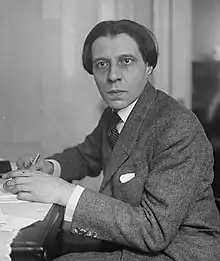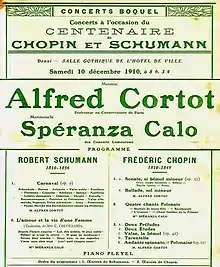Alfred Cortot | |
|---|---|
 Cortot, c. 1920s | |
| Born | Alfred Denis Cortot 26 September 1877 |
| Died | 15 June 1962 (aged 84) Lausanne, Vaud, Switzerland |
| Occupations |
|
| Organizations | École Normale de Musique de Paris |
Alfred Denis Cortot[n 1] (core-TOE; 26 September 1877 – 15 June 1962) was a French pianist, conductor, and teacher who was one of the most renowned classical musicians of the 20th century. A pianist of massive repertory, he was especially valued for his poetic insight into Romantic piano works, particularly those of Chopin, Franck, Saint-Saëns and Schumann.[1][2] For Éditions Durand, he edited editions of almost all piano music by Chopin, Liszt and Schumann.[1]
A central figure of the French musical culture in his time, he was well known for his piano trio with violinist Jacques Thibaud and cellist Pablo Casals.[1]
Biography
Early life
Cortot was born in Nyon, Vaud, in the French-speaking part of Switzerland, to a French father and a Swiss mother. His nationality was French.[3] His first cousin was the composer Edgard Varèse.[4] He studied at the Paris Conservatoire with Émile Decombes (a student of Frédéric Chopin), and with Louis Diémer, taking a premier prix in 1896. He made his debut at the Concerts Colonne in 1897, playing Beethoven's Piano Concerto No. 3.
Between 1898 and 1901 he was a choral coach and subsequently an assistant conductor at the Bayreuth Festival. In 1902 he conducted the Paris premiere of Wagner's music drama Götterdämmerung (The Twilight of the Gods). He formed a concert society named Société des Concerts[5] to perform Wagner's Parsifal, Beethoven's Missa solemnis, Brahms' German Requiem, and new works by French composers.[1]
Career

In 1905, Cortot formed a trio with Jacques Thibaud and Pablo Casals, which established itself as the leading piano trio of its era. In 1907, he was appointed Professor by Gabriel Fauré at the Conservatoire de Paris, replacing Raoul Pugno. He continued to teach at the Paris Conservatoire until 1923, where his pupils included Yvonne Lefébure, Vlado Perlemuter, Simone Plé-Caussade, Magdeleine Brard, Marguerite Monnot, and Rodica Sutzu.
In 1919, Cortot founded the École Normale de Musique de Paris. His courses in musical interpretation were legendary. For his many notable students, see here.
As a leading musical figure, Cortot traveled for many international music events. The French government sponsored two promotional tours to the United States and one to the Soviet Union in 1920. He conducted several orchestras and was often called upon to provide piano accompaniment for touring artists when in Paris. He was involved in music until his health failed, and taught master classes in piano in his advanced years.
On 21 March 1925, Cortot made the world's first commercial electrical recording of classical music for the Victor Talking Machine Company in Camden, New Jersey: Chopin's Impromptus and Schubert's Litanei, issued on Victor's Red Seal label.[6]
World War II
During World War II, he accepted the position of Haut-Commissaire ("High Commissioner") for arts in the Vichy government and served twice (1941 and 1942) as a member of the Vichy's Conseil national ("National Council")[7][8][9]. However, before this he took a strong stance in defending the French music tradition with the Beaux Arts administration (Fine Arts) supporting soldiers with music.[10] Cortot had to leave this position after Pétain's appointment and exerted his energy instead into writing reports about cultural propaganda and defending French musical styles. He was charged with musical reform by the Pétain government, and the Vichy took control of musical activities. He became part of the comité d'organisation professionelle de la musique (The committee for the professional organisation of music) in 1942 and worked with Laval and Pétain.[10]
In 1941 he participated in a Propaganda Staffel (Propaganda Squad) festival in Paris, and in 1942 played with Wilhelm Kempff for Nazi artist Arno Breker's art exposition, later meeting with Breker at Paul Morand's home. Pierre Laval was also present. Morand had a statue made of Cortot after his impression.[10] He participated in official concerts in Paris during the occupation as well as in Germany in 1942.[7]
Daisy Fancourt writes:
After the war's conclusion, Cortot was found guilty by a French government panel of collaboration with the enemy and was suspended from performing for a year.[11] He said in his defence, "I've given 50 years of my life to the helping the French cause [...] when I was asked to become involved with the interests of my comrades, I felt I couldn't refuse. [...] I represented the interests of the French government less than the interests of France. [...] I have never been involved in politics."[10] Once the suspension expired he returned to performing more than 100 concerts a season.[8]
Death
Cortot died on 15 June 1962, aged 84, of uremia from kidney failure in Lausanne, Switzerland.[2] His son was the painter, Jean Cortot.[12]
Contribution
As one of the most celebrated piano interpreters of Chopin, Schumann and Debussy, Cortot produced printed editions of the piano works of all three, notable for their inclusion of meticulous commentary on technical problems and matters of interpretation.[13]
Cortot suffered from memory lapses in concert (particularly notable from the 1940s onwards) and often left wrong notes on his later records.[14] When in form, however, he showed a brilliant technique that could handle almost any kind of pianistic firework. This gift is evident in his legendary recordings of Liszt's Sonata in B minor (the first recording ever made of this masterwork) and Saint-Saëns' Etude en forme de valse. The latter thoroughly impressed even Vladimir Horowitz, who – according to Cortot – approached Cortot to learn his "secret" in performing it; Cortot, however, did not divulge it to him.[15]
He also wrote a good deal of didactic prose, including a piano primer: Rational Principles of Pianoforte Technique. This book contains many finger exercises to aid in the development of various aspects of piano playing technique.[16]
Bibliography
Notes
- ↑ also Cortôt, French-European spelling
References
- 1 2 3 4 5 6 7 Cooper, Martin (2001). "Cortot, Alfred". Grove Music Online. Revised by Charles Timbrell. Oxford: Oxford University Press. doi:10.1093/gmo/9781561592630.article.06587. ISBN 978-1-56159-263-0. (subscription or UK public library membership required)
- 1 2 "Alfred Cortot, Pianist, Is Dead. Soloist and Conductor, 84, Backed Vichy Regime". The New York Times. 16 June 1962.
- ↑ Anselmini, Francois (2012). "Alfred Cortot musicien du XXe siècle, perspectives biographiques". Actes des conferences: Journées internationales Alfred Cortot, Tournus, 4–8 juillet 2012, sur gallica.BNF.fr, pp. 13–46 (in French): 14 – via Gallica.
- ↑ Varèse, Edgard; Jolivet, André (2002). Jolivet-Erlih, Christine, ed. Correspondance 1931–1965 (in French). Contrechamps. p. 110
- ↑ "Alfred-Denis Cortot | French pianist". Encyclopedia Britannica. Retrieved 28 August 2021.
- ↑ 40,000 Years of Music: Man in Search of Music – 144 Jacques Chailley – 1964 "On March 21st, 1925, Alfred Cortot made for the Victor Co., in Camden, New Jersey, the first classical recording to employ a new technique, thanks to which the gramophone was to play an important part in musical life: electric ..."
- 1 2 'Alfred Denis Cortot', The Fryderyk Chopin Institut Archived 19 September 2020 at the Wayback Machine, accessed 13 January 2018.
- 1 2 David Dubal booklet to Nimbus Records release of Duo-Art piano rolls "Nimbus Records, Grand Piano, NI 8814, Alfred Cortot plays Chopin, Liszt, Beethoven, Skriabin Saint-Saëns & Chabrier – Booklet Note". Archived from the original on 16 May 2008. Retrieved 18 April 2008.
- ↑ France The Dark Years 1940–1944 by Julian T. Jackson, published in 2003 by Oxford University Press
- 1 2 3 4 5 "Music and the Holocaust: Cortot, Alfred". holocaustmusic.ort.org. Retrieved 22 November 2019.
- ↑ Chimènes, Myriam, 'Alfred Cortot et la politique musicale du gouvernement de Vichy' in La vie musicale sous Vichy, ed Chimènes (2001) ISBN 2 87027 864 0 , reviewed by Nigel Simeone, Musical Times, Vol. 142, No. 1876 (2001)
- ↑ Gubanski, Mathilde. "Jean Cortot". Diane de Polignac Gallery. Retrieved 12 January 2024.
- ↑ "Category:Cortot, Alfred/Editor".
- ↑ Bambarger, Bradley. "Alfred Cortot". Steinway & Sons. Retrieved 8 June 2021.
- ↑ Isacoff, Stuart (28 November 2005). "The Master Speaks … and Plays". The New York Sun. Archived from the original on 10 April 2021. Retrieved 8 June 2021.
- ↑ Chiantore, Luca (2019). Tone Moves: A History of Piano Technique. Barcelona: Musikeon Books. pp. 668–670. ISBN 978-8494511738.
Sources
- Gavoty, Bernard, Alfred Cortot, 1977 (in French)
- Manshardt, Thomas, Aspects of Cortot, 1994
External links
- Guide to Alfred Cortot Collection, 1491–1853 housed at the University of Kentucky Libraries Special Collections Research Center
- Recordings